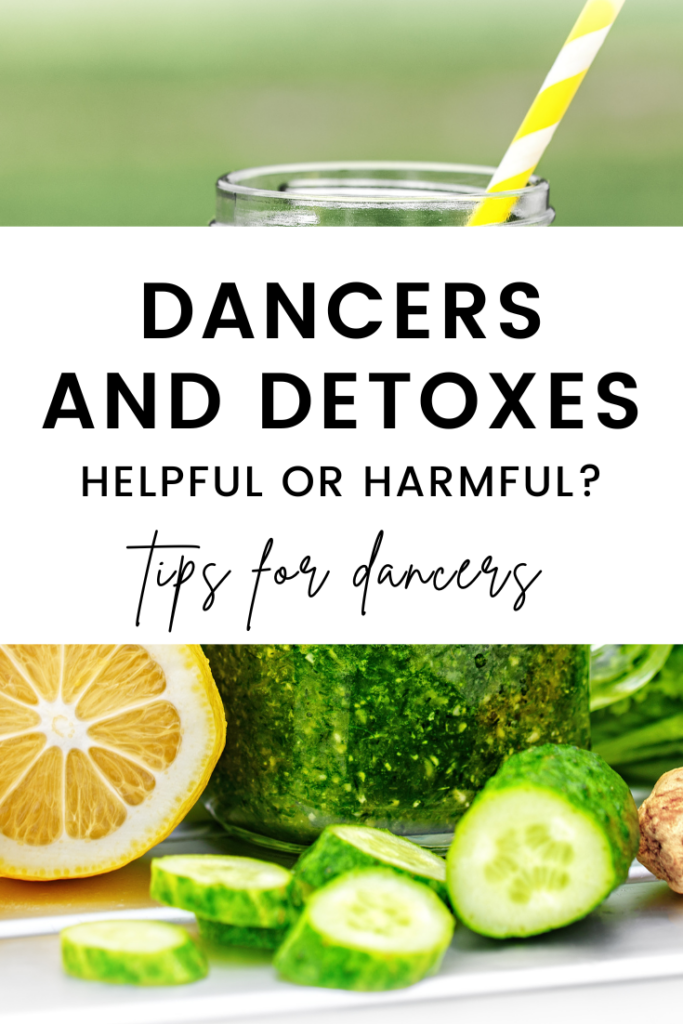Dancers are known for their discipline and dedication to their craft. Maintaining a strong, agile body is essential for their performance on stage. However, undeniable food and body ideals can lead dancers to explore drastic measures, such as cleanses and detoxes, in pursuit of rapid weight loss or supposed “detoxification” methods. In this blog post, we will discuss why dancers should avoid cleanses and detoxes, and uncover how to embrace a more inclusive approach to nourishing their bodies.
What is a detox?
When dancers inquire about “detoxing,” it usually follows a period of eating, perhaps more than usual, food that diet culture deems to be more indulgent (ie. sweets, dessert). A holiday weekend, end-of-the-year parties, and vacations are common examples. The belief is that relying on a mix of water, teas, and juices to “cleanse” the body will speed up the removal of “toxins” or digestive and metabolic waste from the body.
Sounds helpful!
Ridding the body of waste is an important part of human biology. The body is naturally equipped to do just that— organs like the liver, kidneys, lungs, and skin all play a role in excreting both digestive and metabolic waste from the body. Here’s the catch… these organs don’t need the assistance of expensive cleanses or fasting detoxes!
Sure, staying hydrated will help your kidneys function. Incorporating foods rich in fiber like whole grains helps with digestive regularity, ultimately supporting your ability to go to the bathroom. And last, adding a variety of colorful produce to your diet— those rich in antioxidants and phytonutrients will support your liver and lungs. Beyond these standard *healthy* diet recommendations, there’s no need to turn to extreme detoxes or cleanses.
5 Pitfalls of Detoxes for Dancers
#1: Insufficient Nutrient Intake
Cleanses and detoxes often involve a high degree of calorie restriction, limited food choices, or liquid-only ”meal” plans. These regimens are often encouraged after a period of fasting and when supplements are involved, they’re both expensive and potentially unsafe.
Not only do calorie restrictions impose negative implications on performance, but also, these practices can also result in a significant reduction in essential nutrients required for optimal physical and mental performance. A dancer’s energy demands are comparable to those of an athlete— the need for an adequate intake of macronutrients (carbohydrates, proteins, and fats) and micronutrients (vitamins and minerals) is critical. Restrictive cleanses and detoxes can compromise their ability to meet these nutritional requirements, leading to fatigue, weakened muscles, and impaired cognitive function.
#2: Declines in Strength and Endurance
Dancers rely on their muscular strength and endurance to execute complex movements and perform with precision. Cleanses and detoxes often deprive the body of the necessary proteins and carbohydrates needed for muscle repair, maintenance, and energy production. Insufficient nutrient intake can result in muscle loss, decreased strength, and reduced stamina, ultimately hindering a dancer’s performance capabilities.
#3: Increased Injury Risk
Engaging in restrictive cleanses and detoxes can compromise the immune system and increase a dancer’s susceptibility to injuries. Nutrient deficiencies can affect bone health, leading to an increased risk of stress fractures and decreased bone density. Moreover, insufficient intake of antioxidants and anti-inflammatory nutrients can impair the body’s ability to repair damaged tissues, making it harder for dancers to recover from intense rehearsals and performances.
#4: Disordered Eating
Cleanses and detoxes can inadvertently contribute to disordered eating patterns among dancers. These extreme dietary practices can lead to an obsessive fixation on food, weight, and body image. Dancers who fall into the trap of cleanses and detoxes may develop an unsupportive relationship with food, which can have long-lasting psychological effects.
#5: Safety
As previously mentioned, the supplement industry is largely unregulated. Many cleanse powders, drinks, and mixtures fall under the category of “dietary supplements” and therefore, may not be accurately measured for safety.
What about the claims?
Over the years, detoxes have played a major role in the glam of the wellness industry— largely driven by consumer fear. We even see this “clean,” “pure,” and “detoxifying” rhetoric seep into the skincare industry. But anecdotal claims like improvements in energy, clearer skin, and better digestion can often be attributed to the benefits of extra hydration.
Key takeaway: do dancers need to detox?
Cleanses and detoxes may promise quick fixes, but they come with many risks and disadvantages for dancers. The body is naturally designed to manage its detox; from the liver and skin to our intestines, we are metabolically wired to excrete waste that builds from natural metabolism. Glorified detox cleanses suggest that our current livelihoods are damaged and in need of “fixing.” That’s not a positive platform for anyone.
The physical demands of dance require a balanced and nourishing approach to fuel the body, support muscle strength, and prevent injuries. If you’re someone who likes the taste of the juice, then you can add it to your routine as part of a balanced meal or snack. But as a dietitian for dancers, I don’t encourage that these drinks replace meals or snacks. Rather, dancers should prioritize guidance from qualified nutrition professionals like licensed dietitians who understand their unique needs.
The Healthy Dancer® Diet Detox
Every January, I host The Healthy Dancer® Diet Detox. This is a free 5-day guided practice designed to help dancers kickstart the New Year right: detoxing from dancer diet culture. Click here to sign up.



